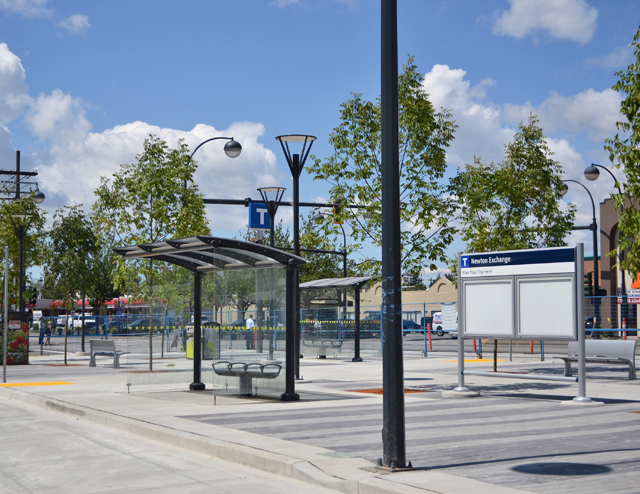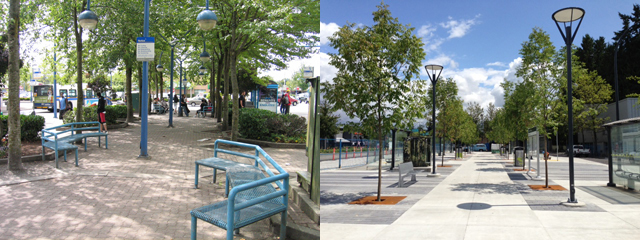The newly renovated Newton Exchange is now open!
The newly renovated Newton Exchange is now open!

The newly renovated Newton Exchange opens today! That’s right. We blogged about the start of construction in March, and now it’s done.
Changes have been made to pretty much everything including paving of the pedestrian area, shelters, lighting, signage and trees–all designed to enhance accessibility, safety, visibility and comfort. In order to accommodate the Newton Exchange to Guildford B-Line service starting in the fall, new layover spots have been created as well as updates to the curb and aisle paving.
Walking around the exchange last week, I couldn’t help but notice some of the details of the exchange including some smartly designed benches, trash/recycling receptacles that use solar power to crush contents, tactile strips on bus stops and our transit “T”!

Check out the TransLink website for a little more info on the exchange. Also, take a gander at this before and after comparison of the exchange. Remember, as the trees grow the exchange will look a little different as time passes.

If you’ve visited the newly renovated exchange, let us know what you think!






I suppose it’s better but I’m sighing. Why is it that trees are cut down and then replaced with little baby trees – it’s going to take ages for them to grow to the size of what was there. Was there no way to save them?
Also with the shrubs gone I find the exchange to be sterile. A broken line of them down the center runway would have improved the look of it – maybe some heavy duty planters now?
Before anyone asks, my parents live nearby so I have been to the exchange.
Looks great! Larger trees are a safety hazard I assume; they block light and give creeps a place to hide.
Hi Sheba: Thanks for the question. I though we’d get one along the lines that you’re asking. The team who worked on the exchange provided me with an explanation about the trees. Here it is:
During design, the project team carefully considered whether to retain the existing trees. Unfortunately, an arbourist assessment indicated that a number of the trees were unhealthy and were planted in soil conditions allowed roots to cause heaving in the surface of the exchange. The decision was taken to replace the trees. This allowed for planting a new species in structural soil. This should result in healthier trees that do not damage the new paving. Over time, the trees will grow to offer additional shade.
I agree with Sheba, in that it looks sterile. The shrubs made a difference. The exposed soil made the biggest difference, I think. It all gave the exchange a park-like feel.
I support Translink on the tree replacement. We should trust an arborist on this issue.
I see so few bus shelters, that I want to use sarcasm. A positive suggestion instead: use Indiegogo to crowd fund for more bus shelters. Translink, are you allowed to do that?
My beef against the trees being chopped down is that I’ve heard the exchange is supposed to move in a number of years. I’m guessing the new trees won’t be able to handle the move, so they’ll be chopped down to make way for another set of new trees. Couldn’t we have just made do with the old trees for a little longer and then gone with new trees for the new location?
The old exchange was park-like. I hope large planters are added to bring some of that back.
A little off-topic but I figured I’d copy/paste this up here:
I did some digging. Of note: Area transit plans complement other transit/transportation planning processes, ranging from the update to the Regional Transportation Strategy to annual plans (including recent service optimization). Here’s the list:
Area Transit Plans – year complete.
Burnaby/New Westminster – 2003
Northeast Sector – update currently underway (expecting to complete in 2014)
North Shore – 2012
Pitt Meadows/Maple Ridge – 2004
Richmond – 2000 (looking to begin next plan in 2014)
South of Fraser – 2007
Vancouver/UBC – 2005
If we figure a decade between plans (because you know Vancouver is going to get extra time) then Surrey has a long time to wait…